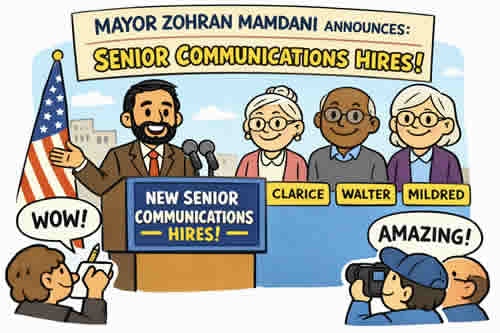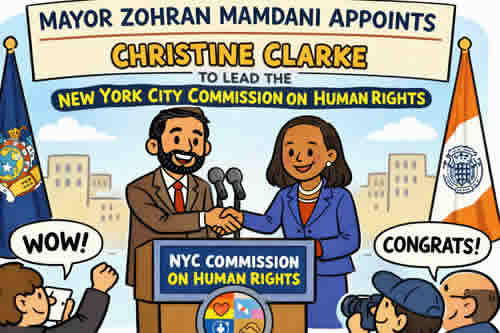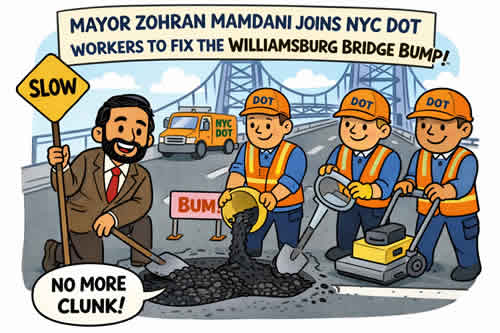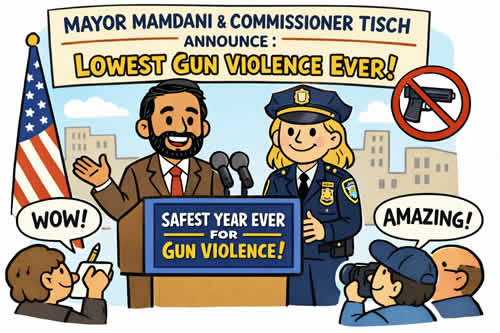July 26, 2023
Deputy Mayor Anne Williams-Isom, Health and Human Services: Good afternoon. I’m Deputy Mayor Anne Williams-Isom, the deputy mayor for Health and Human Services, and welcome to this week’s Asylum Seeker Briefing. Joining me today is Commissioner Zach Iscol, the commissioner of New York City Emergency Management, and Dr. Ted Long, the senior vice president at New York City Health and Hospitals. New York City continues to respond to this humanitarian crisis, work with partners and call for additional resources, because we cannot continue handling this without more support. As a number of asylum seekers in our care surpasses 56,200 today, we are announcing a new Humanitarian Relief Center to serve adults seeking asylum.
In partnership with New York State, the city will soon construct and open a humanitarian relief center that will serve up to 1,000 adult men seeking shelter in the parking lot at Creedmor Psychiatric Center in Queens. We are very grateful to the state for its support in providing the space. We also are grateful for their commitment to reimburse the city for all costs of this site, including construction, maintenance and staffing. This is especially true as the city has already spent more than $1.5 billion on this crisis and expects to spend a total of $4.35 billion at the end of next June.
Construction will begin in the coming weeks and we hope to open the site shortly after that. This will allow for some relief and some space for children with families. I also want to provide an update on the 60 day policy for asylum seekers that we announced last week. This week, we began notices to adults in humanitarian relief centers and will continue to issue these notices on a rolling basis. Over the coming months, our trained caseworkers will work closely with people to help them move forward on their journey and to find a place to settle. Dr. Long will be able to provide more information about that when we take some questions.
As we have repeatedly said, of the more than 93,000 people who have come through our system, we know that roughly 37,000 people have moved on to their next step in the journey, whether that is here or across the country. We want to make sure that we are meeting those people where they are and helping people to settle in other places outside of the shelter system. Before I turn it over to Zach, to delve into the details of our new Humanitarian Relief Center, let me share some of the latest data. As of July 23rd, we have over 107,300 people who are in our care. This includes the over 56,200 asylum seeker. This is putting an enormous strain on the system. Since last spring, we have more than 93,200 people come through our system, seeking asylum.
We have now opened over 192 sites, including 13 humanitarian relief sites, and that doesn’t include the current facility at Creedmor that we just announced today, nor does it include the facility at Hall Street that will open next month as a humanitarian relief center. And last week from July 17th to July 23rd, we had 2,900 asylum seekers enter our system. As you can see, these numbers are high, they continue to be high week after week. We’re getting thousands of people who are coming to New York City and wanting shelter and seeking asylum. Let me now turn it over to Commissioner Zack to discuss a few of the details of the new relief space at Creedmor.
Commissioner Zach Iscol, New York City, Emergency Management: Thank you, Deputy Mayor Williams-Isom. Your efforts and dedicated leadership throughout this humanitarian crisis have been nothing short of exemplary. It’s through your leadership and the administration at large that we’ve been able to make this announcement today and get to where we are. This work has been amongst some of the most challenging I have certainly done in my life. Every day is a full on sprint as we look to place hundreds of people and find places for them every single day. And I will just say, I wish every New Yorker could be exposed to what it is like working for Deputy Mayor Williams-Isom behind the scenes. William Wallace has nothing on her when she is rallying the troops to the cause through her spirit and faith. And so it’s really been incredible working with you, so thank you.
I also share your deep concerns as the number of asylum seekers in New York City rises. They all seek refuge and a new start and it has been and continues to be our duty to assist. However, as we continue to make clear, this cannot just be a city issue, it’s a national issue and we’re using all available resources and we continue to call on the national government for support. To accommodate and support this growing number of individuals, we’re opening, opening our latest humanitarian emergency response and relief center, thanks to the cooperation from New York State. This center will provide not just a place to stay, but also critical services to support these individuals on their journey. At this center, we’re focusing on providing support to single adult men who are seeking asylum, who have recently arrived in New York City. It’s important to note that while this is a large scale effort, it’s also a deeply personal one.
Each person we’re helping is an individual with their own story and their own struggles. As we begin to prepare the site, we hope to have it operational as soon as early August, this site was selected after thoughtful consideration and close coordination with New York state officials. We evaluated multiple factors to make this decision, including minimizing disruption of existing services and programming, and being in the best condition to quickly provide the services needed. Upon completion, this center will have the capacity to serve about 1,000 asylum seekers, replicating the range of services we’ve been providing at our existing humanitarian relief centers.
This includes immediate access to medical aid, meals and help with reconnections. This facility will be climate controlled for comfort, the construction phase is projected to last a couple of weeks. Let me close by saying this New York City is doing everything in its power to provide supportive humanitarian services to these individuals during this challenging time, but we really cannot do this alone. This is a national issue that demands federal support. We are ready and hopeful for collaboration to ensure everyone gets the necessary support. Now I’ll turn it back over to our Deputy Mayor Williams-Isom. Thanks.
Deputy Mayor Williams-Isom: Thank you so much, commissioner. And you do make the point, I do try to lead with love and with faith and with determination and make tough decisions. And when this does get hard, I get my hope by spending time with the migrants. This morning I went to a site and I was able to see migrant children, I shouldn’t say migrant children, children running around with the library, very excited, picking out books. I saw volunteers of high school students here in New York City, who are volunteering at the site to make sure that people have the clothes that they need, the support that they need.
I saw people asking for legal services and I know, and I think that that’s what gives me hope, what we’re doing here in New York City is what we’ve always done. We’ve opened up our arms and we’re trying to do the best that we can. But I know that as we continue to get support from our federal delegation, which I am so grateful for, as we continue to work with our state partners, we can get through this, but we can’t get through it on our own. And I think that if we all rally together, if we all see what New York City is doing and replicate that, we can get through this crisis. With that, I’ll open it up for questions.
Question: Thank you. With the contract from the states, is this one that the state recently procured and is the state going to be taking care of everything when it comes to these shelters, including not only building it, but services, staff and so forth? And then one more question. There is a plan I’ve been hearing from your staff, to move migrants upstate. Just wondering how many migrants have been moved upstate? What does that program look like? How many spaces are available? Is that happening every week, every day? Just a little more details on that program.
Deputy Mayor Williams-Isom: Sure. With over 93,000 people coming to us thus far, we’ve always had a large plan about what are we going to do and how are we going to address each part of this? The state will be reimbursing us for this, so we will do it as we’ve done every other humanitarian relief center and they will reimburse us for the construction and for all the costs that are associated with that. The upstate plan is the plan that we announced a couple of months ago, maybe now. I remember when we had some executives here from upstate who have opened up their arms. And so we’re continuing to work with those that are willing, the best of the best us to move people upstate.
I think the number is maybe over 1,500 folks that are upstate right now, but I’ll make sure that we get that number for you. And that in the original plan that we did in March, called the Asylum Seeker Blueprint, the state said that they were going to work with us to relocate about 1,200 families. And so that work is continuing as we connect that to the legal clinic that we opened a couple of months ago to make sure that people are on their pathway to filling out their forms and so that they can get work authorization and then resettle children and families upstate. You’re welcome.
Question: Do you guys have any numbers as far as the 60 day notices to those who have been longest in shelter? I don’t know if you have any numbers as to how many have been given notice and how many have left the system. Or if you don’t have numbers, even just generally speaking, what that experience has been like?
Deputy Mayor Williams-Isom: Dr. Long?
Dr. Ted Long, Senior Vice President, Ambulatory Care and Population Health, NYC Health + Hospitals: Yeah, in terms of the specific numbers, we’ve delivered over 100 notices at this point. And just to take a step back, I want to emphasize about the 60 day notices, that our focus and opportunity here is the case management part of all of this, or in other words, how we can help you with where you are now. As the deputy mayor said, we’ve now taken care of more than 93,000 asylum seekers in New York City. Among those 93,000, with our help, around 40 percent have been able to take the next step forward in their journey and exit our city system. So we know what to do, we know how to be effective and we’re applying those principles through case management in every discussion we’re having now. But one of the things we’re realizing is that when we’re starting to have these discussions around the notices, people are not surprised.
In fact, they’re coming to us with questions, things they need help with, which is what we welcome. For example, we’re hearing from asylum seekers that we’ve given notices to, that they need help getting IDs, they need help navigating how to travel. They need help even with specific types of legal services. When we hear all of that feedback from them, we can immediately put plans in place to meet them where they are and give them the specific help that they need so they can take the next step forward in their journey. So as we go forward with our case management, the opportunity is for us to learn at this stage of the asylum seeker crisis, what exactly people’s needs are, which we’re doing right now, and we’ll meet those needs to be as effective as we can be.
Deputy Mayor Williams-Isom: Hi Liz.
Question: I wanted to ask you about a story that my colleagues published last night, also the city has done some coverage on deteriorating conditions at some of the shelters with respect to spoiled food, lack of sufficient showers, lack of air conditioning. What is the city doing to address that? Is that part of the reason that we’re seeing the city asking for bids to bring in contractors?
Deputy Mayor Williams-Isom: The way that I would answer that is it is something that we are very concerned about because the system is under an enormous amount of strain. When you think about really doubling the amount of people who are in our care from when we first got here, that’s about space, it’s about personnel and people and it’s about resources. And so I think that we are so proud that we have not had anybody sleeping on the street. But I think that you’re right that there are places where we’re like, “We got to make sure that we get the showers working. We got to make sure that we have the food the way it needs to be. We’ve got to make sure that people are getting the basic, that we want to make sure.”
I think that’s why we need help. I think that’s why we keep on saying, “We’re out of space. We need support, we need more places.” 192 sites, Liz. There’s going to be places where it’s like, “What’s going on this evening?” Commissioner Zack can speak to that because they’re really overseeing some of those emergency respite centers. But I think this is why we really feel like it’s a national issue that needs some national support so that we can really have people in the places that they need to be. Nobody wants to be in a hotel.
Question: What have your conversations with federal officials been like? Do you talk to them weekly? Are you moving forward towards a new policy idea, towards more aid?
Deputy Mayor Williams-Isom: Yeah, we always have new policy ideas. I say to people, we’ve been planning from day one and we continue to plan. We’ve had some great meetings with our federal delegation. They’ve come and they’ve visited and they’ve seen the amazing work that’s going on at the Roosevelt. I say amazing, but it’s bittersweet when you walk in there and you see the hundreds of people who are waiting on chairs and the hundreds of people that come every day. I think some are seeing something they didn’t realize. They thought that things since things were slowing down at the border, that they’ve slowed down in New York City and that is just not the experience.
So I think the more people see it and feel it, we see other people in this nation who are not treating migrants well. I want people to see how well New York City is treating migrants, but that we need help because we cannot do this on our own. And that we really think a decompression strategy, allowing people to work would really help us and give some relief to these folks who have come here for the American dream.
Commissioner Iscol: Just to your question and just piggybacking off what deputy mayor said, emergency management 101, the local jurisdiction is supposed to be able to turn to the state and the federal government for support when they have run the course, when they’ve run out of resources, the ability to handle the emergency. We’ve long passed that. And so these issues that we’re facing, this is really because like we are at capacity.
We’ve been saying this now for weeks, if not months, if not longer. The last time the US had a migration crisis of this magnitude, one of them was the Mariel boat lift for Cuban refugees. That was a federally declared disaster. The numbers that we’re seeing in New York City are on par with the numbers of Cuban exiles and refugees that were coming into Florida. And President Carter acted, that lasted months, but the city has taken on something of that magnitude largely on its own.
Question: On the question of moving more asylum seekers upstate, I know that a lot of counties and localities have moved to stop that from happening and there’s litigation in the works. Have any additional counties or localities done the opposite and said, “We want to help?” Have there been conversations with the governor about facilitating more of that?
Deputy Mayor Williams-Isom: I would say yes and yes. And I think as we continue to plan, as I mentioned the resettlement program that the state has agreed to, there are definitely counties that have said, “We want more information, we want to be able to work with you.” And so we’re working with them in order to get that done. I can give you that information after this, but I think that’s what I just want to focus on. There’s many people who say no, but there’s many more people who are saying yes and who see that this is an issue and want to stand out.
Question: Commissioner, you said that the city’s running out of resources, but a BID [inaudible] was put in the city records, saying it’s a $69 million contract to staff these facilities. Also, H&H just put out a bid to manage all the parks. So is there going to be a point where the city actually does run out of resources? Will this come out of the budget and what is your plan B? Because you haven’t gotten any more money from the federal government and that request has fallen on deaf ears, so what’s the plan? And you guys are still shelling out money?
Deputy Mayor Williams-Isom: Do you want to start?
Commissioner Iscol: Sure.
Deputy Mayor Williams-Isom: And then I’ll clean it up.
Commissioner Iscol: We’re going to continue to bail water and that’s what we’re doing. And we’re going to continue to work every day just the way we have been doing. But it is a full on sprint every single day, looking for places to place people.
Deputy Mayor Williams-Isom: It’s funny that he says a sprint because it’s more like feels like a marathon that we’ve been trying to sprint, which, anybody who’s run a marathon know that we can’t do that. And so I think that we see in this country, what it looks like when people are not treating migrants well. We are treating migrants as best as we can, and so we’re going to continue to do that and we’re asking for the federal government to support us in this work that we’re doing, because we think that with a decompression strategy and if people can work, we will be able to manage this as a nation and I think people will be proud of that.
Dr. Long: Can I add? Would it be okay if I add something before you guys? Sorry, multitasking. Just two points I wanted to make, first on the H&H specific question around the RFP, just to be crystal clear, the RFP is for us continuing the same structure we have, but putting it out to bid to see who the best staff members would be at my sites. They remain my sites, HH has complete control over management of all the sites, complete responsibility. I have somebody on site 24/7 and none of that changes. It’s a standard contracting process to put out an RFP to continue staffing, though. I did also also want to make a point around the strain that we’re under. Every day, as the deputy mayor and the commissioner is saying, it gets harder and harder for us.
We’re working 24/7, around the clock. The arrival center, we have families with children that are coming to us at midnight every night. So we’ve, for example, opened up the ballrooms in our hotels, trying to be creative in New York City, trying to give people the dignified welcome that they deserve, hoping we would never need to use these ballrooms. Tonight, we’ll use every ballroom I have. It’s not because we want to, it’s because we have to, given the strain that we’re under, given the number of people coming in. Even the most effective approaches that we have, we need more help than we’ve been getting.
Question: On this 60 day rule also, why have only 100 been sent out? Is this a retroactive rule? That’s something the mayor wasn’t even clear on two days ago.
Dr. Long: The people initially that we’re giving the notices to are the people that have been in our system for the longest. So we’re doing delivering the notices on a rolling basis, starting with the people that have been in our system for the longest.
Question: What’s the longest?
Dr. Long: I’ll have to double check that.
Deputy Mayor Williams-Isom: I think the point is we want to make space for families with children, and so now we’re looking at all of the tools that we can use in order to do it. And we’ll give you more information as things continue. We’ll see whether or not this works or doesn’t work, but we’re trying to do the best that we can so we can make room for families with children.
NYC New York City Hall Mayor Eric Adams office news – Big New York news BigNY.com










